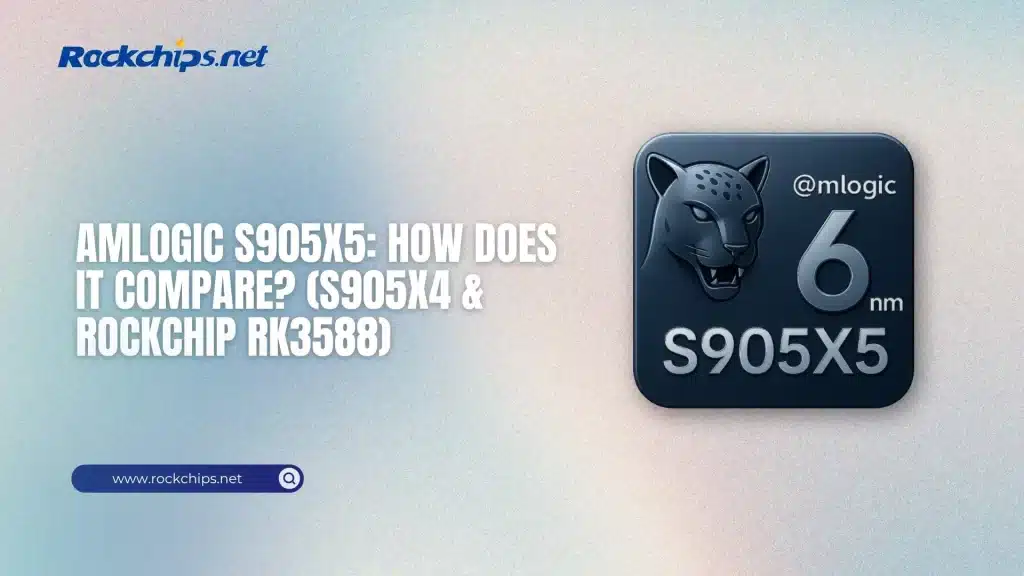
The Amlogic S905X5 is a modern TV-box SoC (system-on-chip) designed to bring next-generation video codecs, improved CPU/GPU efficiency, and on-device AI features to Android TV boxes, set-top boxes and other smart-device applications. Below I explain the S905X5’s strengths and trade-offs, compare it with its immediate predecessor (S905X4) and a higher-end Rockchip alternative (RK3588), and summarize what the silicon choice means for OEMs, integrators and end users. Sources used are listed inline for readers who want technical datasheets and community testing.
Why does the Amlogic S905X5 matter?
The S905X5 targets the mainstream/upper-mainstream TV-box market by adding modern video codec support (including AV1 and newer codecs), an Armv9 core cluster for improved CPU efficiency, and an on-chip NPU (neural processing unit) to accelerate AI features such as AI-Super-Resolution (AI-SR). That combination makes the S905X5 well suited for Android 13/14 TV user interfaces, improved streaming efficiency, and low-power AI upscaling on inexpensive hardware.
Quick technical snapshot (Amlogic S905X5)
- Family/target: TV / OTT set-top boxes, smart-boxes.
- CPU: Quad-core Armv9 (Cortex-A510 family reported in early announcements).
- GPU: Mali-G310 (Valhall-derived) for UIs and light graphics.
- Process node: Modern 6 nm class (improved efficiency vs S905X4’s 12 nm).
- Video: Hardware decode for AV1, H.266/VVC (newer implementations vary by SKU), H.265/HEVC and legacy codecs.
- NPU: ≈4 TOPS enabling local AI features like AI-SR.
- Memory: Device implementations typically ship with LPDDR4/LPDDR4X, some SKUs target LPDDR5.
Comparison table – Amlogic S905X5 vs S905X4 vs Rockchip RK3588
(Table data pulled from publicly available SoC briefs, vendor pages and hands-on posts – see sources below for full datasheets and community tests).
Practical implications for product makers and end users
For OEMs / box integrators
- S905X5 is attractive when you need modern codec support (AV1 + newer codecs), improved power efficiency, and affordable per-unit BOM. It’s a good fit for Android TV boxes where cost/perf and streaming efficiency matter more than raw compute.
- RK3588 (Rockchip) is the right pick if your product needs multi-camera support, 8K workflows, heavier AI inference, or desktop-class multimedia in a single chip – but expect higher BOM and thermal considerations.
For developers and firmware teams
- Newer Arm architectures (Armv9 on S905X5) change some optimization paths – update toolchains and test media pipelines thoroughly. Firmware and Android images must include the updated VPU/NPU drivers to unlock codec & AI features. Community writeups and datasheets are essential for reliable porting/testing.
For end users
If you stream AV1 content (some platforms already use AV1 for efficiency), an SoC with hardware AV1 decode (like S905X5) lowers CPU load and reduces stutter on 4K streams. For advanced local AI upscaling, the on-chip NPU can improve perceived picture quality – but the final result depends on OEM software.
Sources
- CNX-Software, “Amlogic S905X5 Armv9 TV Box SoC supports AV1, H.266, Ai-SR” (technical overview and early specs).
- Rockchip RK3588datasheet and FriendlyELEC / Rockchip community PDFs (detailed RK3588 capabilities: CPU mix, Mali-G610, VPU/NPU).
- Rockchips.net – product and customization pages (useful for OEMs looking to base devices on Rockchip platforms).
About custom hardware & software services (how we can help)
We design and produce custom TV-boxes, smart-boxes, smart-devices and single-board-computers – and we work with both Amlogic and Rockchip families depending on customer needs. Typical services we provide:
- Hardware selection & SoC trade-off analysis (S905X5 vs S905X4 vs Rockchip RK series).
- Custom board design (PCB, power delivery, thermal plan) and enclosure design.
- Firmware/Android image customization, app integration, DRM & Widevine provisioning.
- Media pipeline tuning (hardware VPU/NPU optimizations, codec licensing support).
- Small to large volume production (prototyping → certification → mass manufacturing).
If you need a cost-optimized Android TV box with AV1 and AI-SR, S905X5-based designs are a natural fit; if you need higher multimedia/AI throughput or SBC flexibility, Rockchip RK-series platforms are a better match. We can prototype, validate performance (video, UI smoothness, AI upscaling) and deliver turn-key devices to your spec. For Rockchip-based projects we often reference resources such as rockchips.net for BSPs and board support materials.
Conclusion
The Amlogic S905X5 brings a meaningful generational step for TV boxes: Armv9 CPU efficiency, modern GPU, hardware AV1 and emerging codec support, and an on-chip NPU to enable lightweight AI features like AI-SR. Compared with the S905X4, it’s a clear evolution in efficiency and multimedia capability; compared with higher-end Rockchip SoCs (RK3588 family), it targets a different sweet spot – better value and streaming-focused features rather than raw multi-core/8K throughput. Choosing the right SoC comes down to the product requirements: price, codecs, AI needs, memory bandwidth and thermal constraints. If you want hands-on help, we provide end-to-end customization – from S905X5 TV-box designs to Rockchip-based smart devices and single-board-computers – and can prototype or scale to production to match your project goals.
Read more: